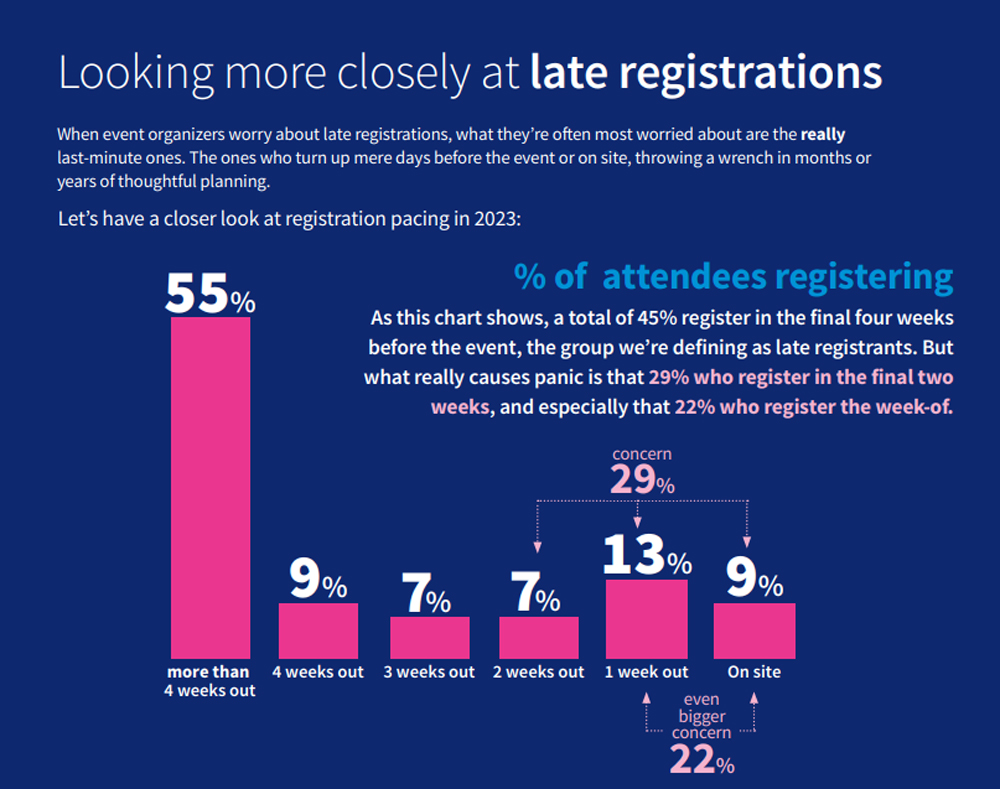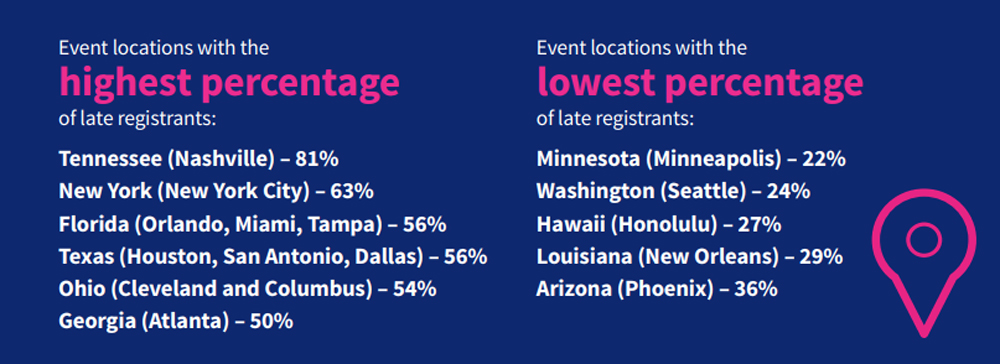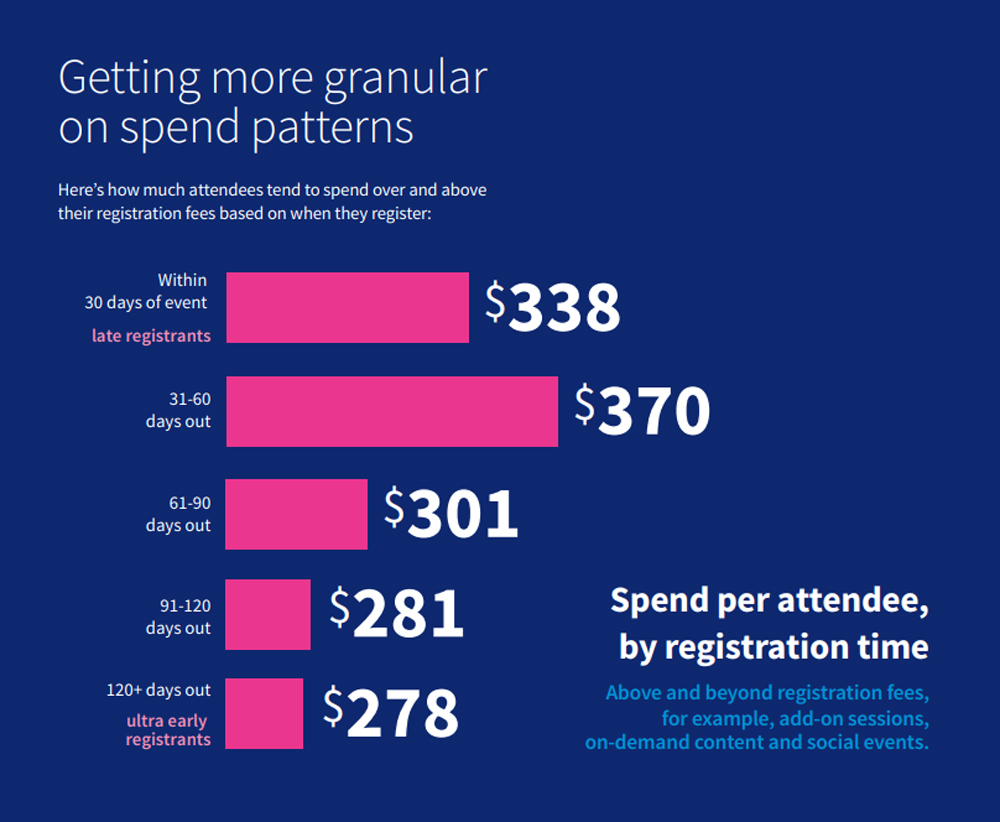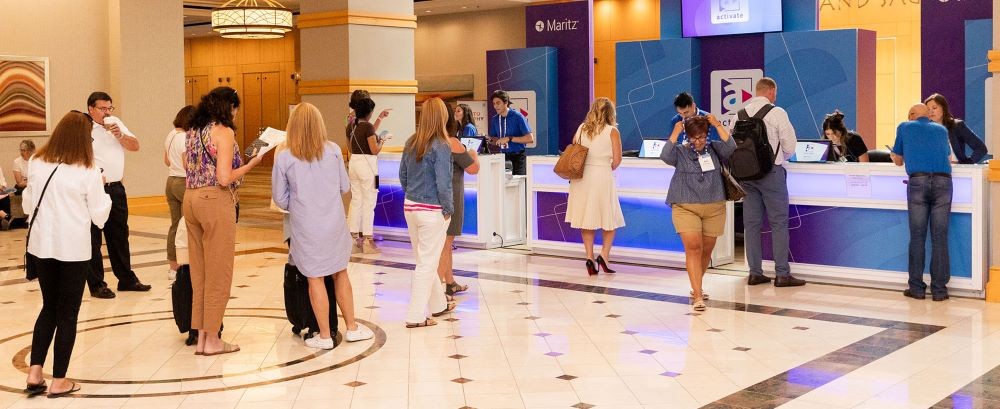Late registrations are the stuff of nightmares for meeting and event planners and stakeholders.
After all, the financial stability of an organization sometimes rests on the numbers coming in, and the closer it gets to showtime, the more the heartburn grows.
But, according to a robust new survey from Maritz, late registrations may actually translate into more ancillary meetings spend by attendees.
[Related podcast: Massive Maritz Study: Late Registrations = Extra Revenue]
Dataset: 360k Attendee Registration Records
Maritz’ new Registration Insights Report, sponsored by Louisville Tourism, tapped three years of attendance data at 30 tradeshows facilitated by Maritz—with a whopping 360,000 individual attendee registration records tallied.
According to Maritz, the global MICE powerhouse noticed changing registration patterns in the meetings and events industry and wanted to understand who is registering late and why in order to align its marketing, pricing and logistic strategies to optimize attendance and revenue.

"I think there's this sense that late registrations are bad. As event organizers we feel a lot of pain around that, we feel a lot of logistical havoc, missing out on bookings in the block," said Emily Laufgraben, market insight manager for Maritz. "And yet we learned from this research that late registrants can actually be some of our most lucrative attendees in terms of how they're spending."
[Related: Live From PCMA CL: Maritz CEO Peckinpaugh Digs Into 2024 Meetings and Events Trends]
Key Survey Results
Eye-opening key data from Maritz’ Registration Insights Report includes the following:
- Nearly one in four attendees (22%) waited until the final week before the show to register
- 9% of attendees didn’t register until they arrived onsite
- 45% of attendees delayed registration until less than four weeks before the event, along with 48% of exhibitors
- The trend toward late registration was in play even before the COVID-19 pandemic, although late registrations spiked during the pandemic era

The consequences of late registrations can be severe, including logistical challenges such as sold-out room blocks, last-minute F&B orders, the number of session rooms and space, support staff strain, transportation needs and limited onsite stock of badges and other materials.
Financial consequences range from missing out on revenue from bookings in the hotel room block; attrition damages for unfilled blocks; and surcharges from suppliers.
Interestingly enough, the survey pointed out that the typical late registrant is a first-time attendee. Almost twice as many first-time attendees (75%) register late as compared to veteran attendees (47%), who typically register early.
Registration scofflaws frequently come from industries that are not known for being “rules followers,” with F&B shows among the biggest laggards. Conversely, doctors, teachers and legal or financial professionals are among the “rules followers” who sign up well before opening day. Early registration in these industries is often driven from continuing education credits being offered for certifications.
Audience research can also gather information on attendees whose personal or professional scheduling constraints may equate to less certainty about attending an event. For instance, according to the Maritz survey, “a 32-year-old woman with young kids faces a very different set of pressures than a 58-year-old male empty-nester.”
Travel distance to events is also a big factor, as those who live within driving distance (within 250 miles of the event location) are much more likely (62%) to register late for an event. Those who need to fly to the event are much more likely to make plans at least a month in advance in order to avoid airfare spikes (39% of flyers register late).

Later Registrants Spend More
While late registrants may keep planners and stakeholders up at night, they tend to spend more on ancillary products at the meeting, over and beyond tiered pricing that increases as the event draws near.
The study found that those who register in the final four weeks on average spend $59 more compared to those who sign up more than 90 days out.

The report outlined the following, more granular information on spend patterns over and above registration fees, based on when attendees register:
- Within 30 days of the event (late registrants): $338
- 31-60 days out: $370
- 61-90 days out: $301
- 91-120 days out: $281
- 120-plus days out: $278
According to the report, the optimal window, or registration sweet spot, is 31-60 days before the event, which provides a healthy balance between revenue optimization and the ability to plan effectively and efficiently. Maritz added that a window of between 31 and 120 days may be a more practical, less heartburn-inducing goal.
Maritz provided the following tips to take advantage of the registration/spend sweet spot:
Optimize Your Marketing
- Don’t open registration too early: Avoid missing out on revenue from opening registration many months in advance before your show offerings are fully available. If you must open early, make it a “soft launch” and save your biggest marketing push for closer to the show date.
- Use FOMO and exclusivity: Consider offering unique privileges and exclusive offers (for example, networking access to VIP speakers and experts) to those who register within your optimal timeframe—create a bit of fear of missing out if they register too late.
- Make registration easy: Simplify your registration form to avoid frustrating your attendees—and causing them to abandon the process. Only ask questions if you’ll truly use the information provided. For those who start the registration process without completing it, seek to understand their reasons. If appropriate, send targeted communications to overcome objections.
Optimize Your Logistics
- Plan accordingly: Knowing that 45% register in the final four weeks, plan for this pattern to avoid surprises. Order that extra badge stock, hire more temps and don’t reduce your hotel room block just because they haven’t registered yet.
- Look at your unique data: Predictors of late registration include living within driving distance of the event and being a first-time attendee. Looking at this data for your own show—including data from past years—can provide a better idea of what to expect.
Optimize Your Pricing
- Rethink early-bird discounts: Not only are these time-based discounts not driving ideal behaviors, they might be giving away money to the very people who would attend your show regardless: repeat attendees. Some show organizers have experimented with alternate pricing models like promo codes or discounts targeted toward specific groups like first-timers or students.
- Align with new attendee behaviors: If you’re not ready to part with early-bird rates quite yet (or you’re worried your audience will revolt), consider offering a less-generous early-bird rate or keeping the rate flat up until four weeks before the event, when the rate jumps much higher. Align those early-bird rates with that 31- to 120-day window you want people to register.
According to Maritz, event organizers should consider sharing more data with suppliers and DMOs, and pricing models should take into account the following:
- Tiers with differing access: Some events are offering one price tier that gives access to the exhibit hall only, while another tier grants access to the full conference.
- VIP packages: Some are offering elite benefits for those willing to pay—anything from front-row seats at keynotes to speaker access to luxury suites and limo transfers.
- Rethinking early-bird pricing: Some are moving early-bird dates later or adding a middle tier to better align with attendee behavior.
- Tiers with session flexibility: This model gives access to more benefits as you move up. For example, entry level includes one keynote and two breakouts, mid-level includes two keynotes and five breakouts, etc.
- Targeted discounts: Some are offering creative discounts via promo codes, sometimes targeted toward specific groups: first-timers, students, adjacent audiences, etc.
- Bundling with membership: More associations are bundling memberships and registration fees together as a pricing package.
To access Martiz/Louisville Tourism’s Registration Insights Report, visit Registration Insights Report by Maritz.







